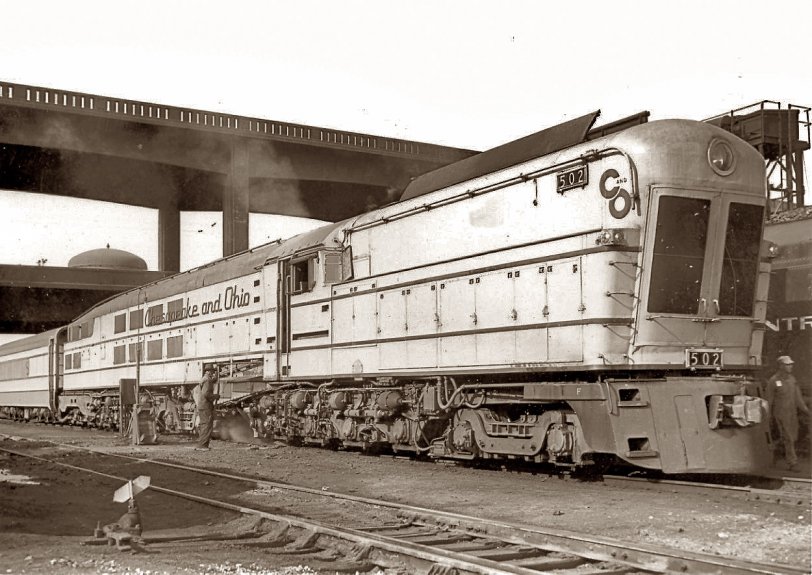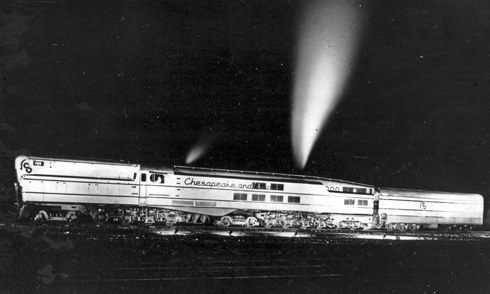


Framed or unframed, desk size to sofa size, printed by us in Arizona and Alabama since 2007. Explore now.
Shorpy is funded by you. Patreon contributors get an ad-free experience.
Learn more.

- Baldwin 62303
- Baldwin VO-1000
- Cold
- No expense spared
- Tough Guys
- Lost in Toyland
- And without gloves
- If I were a blindfolded time traveler
- Smoke Consumer Also Cooks
- Oh that stove!
- Possibly still there?
- What?!?
- $100 Reward
- Freeze Frame
- Texas Flyer wanted
- Just a Year Too Soon
- WWII -- Replacing men with women at the railroad crossing.
- Yes, Icing
- You kids drive me nuts!
- NOT An Easy Job
- I wonder
- Just add window boxes
- Icing Platform?
- Indiana Harbor Belt abides
- Freezing haze
- Corrections (for those who care)
- C&NW at Nelson
- Fallen Flags
- A dangerous job made worse
- Water Stop
Print Emporium
Mechanical Nightmare

Chesapeake & Ohio M-1 steam turbine 502 at Cincinnati on July 2, 1949. These coal-fired turbine locomotives were complete failures in passenger service despite their impressive size and complexity. Built in 1947 by Baldwin Locomotive for exorbitant prices, all three were retired by 1950. Color of this engine, in case you're wondering, was yellow-orange up top with gray beneath, with dark blue lettering and trim. View full size.
Night shot
Here is a photograph that I picked at an antique store. It's a picture of one the locomotives being photographed at night. I’m not sure what the story behind this photo is, but it may be a study for a publicity shot in a magazine or brochure.

Why were they failures
These locomotives were "mechanical nightmares". This was the first advent of a steam turbine being used for railroad service. Think of a jet engine using coal as its fuel. Does not even make sense. The turbines of the UP were basically "jet engines on rails", difference there was they burned the thickest fuel oil you could never imagine, Bunker C Fuel. 100 times thicker than Molasses.
Dollars and Diesel
Yes, these were financial failures, but not because of the fuel they burned. As Anonymous pointed out below, the C&O (and N&W as well) made their money hauling coal. On the face of it, that fuel was in ample supply and they had the facilities to handle it easily so it looked like a no-brainer. Unfortunately, neither road in the late '40s yet fully appreciated that switching from coal (or oil) fired steam to diesel wasn't about the fuel, it was about the labor. Every steam fired locomotive requires an on-board crew to operate it. Diesels can be strung together up to 12 units but controlled from the lead cab by 1 crew. Less crews = less payroll = less overhead = more money to the bottom line. Cha-ching! Plus they didn't (and still don't) require anywhere near the shop forces to support them. Steam locomotives (very much like humans) can be, and often were, fickle, demanding, precocious, temperamental machines in constant need of love and attention in the form of people which equals money. Cha-ching again! Steam locomotives were all of the things I mention above but they could also (again, much like humans) be emotionally evocative. Look at this thread as a tiny example. They had a way of stirring something in the souls of people who were, and are, inclined to respond to such things, myself included. Diesels, however, were (and are) an appliance. Think Toyota Camry. Solid, dependable, loyal appliance. Will get you (or your freight) there all day long and twice on Sundays but won't create much of a breeze thru one's soul. They will, however, return a ton more to the bottom line in exchange for that particular lack of soulfulness. Guess it depends on where one is with the industry; line-side observer or shareholder.
O Gauge M-1
Mike's Train House made an O Gauge version of the M-1 around 2004, priced at $1,000. They are done in great detail. I have one sitting on my shelf in my office and it is a conversation piece.
Financial Failure
To put this in perspective, in the 1940s and 1950s American railroads were changing from steam to diesel power due to cost savings. The C & O transported huge amounts of coal from West Virginia so to them it seemed silly to burn anything else. Baldwin and Westinghouse took on the challenge of building three of the turbines. They were hard and expensive to maintain and didn't get the fuel economy desired. They had problems developing enough steam for the needs of the turbine, but when the fireman could keep the steam up, they ran very good. They were intended to make 6000 horsepower and were going to pull a new state of the art passenger train, the Chessie. Due to a downturn in passenger traffic, as Americans purchased more and more cars and roads improved, the Chessie never ran and the turbines were quietly retired after about three years of trials. It is sad none survive in museums. You can see other images of the locomotives here.
I may actually have seen one!
As a youth in Huntington, I saw a huge strange-looking locomotive waiting on the tracks at the C&O Station on Seventh Avenue. I have often wondered if it was one of these. If this ever pulled the old C&0 "George Washington," then this is what I saw!
C&O Turbines
There is a good history of them on this website. Scroll down.
Why were they failures?
I'm curious... why were these impressive locomotives failures?
M-1 Steam Turbine
I agree, this thing looks awesome. Pity this photo isn't color. I'd love to see its yellow-orange decor.
C&O M-1
This is at the Cincinnati Union Terminal engine service facility. I saw one of these stuffed nose first into one of the roundhouse stalls. It was so long that the section (water carrier?) that can be seen behind the main locomotive was entirely outside. By the way, that was the one and only stall that could be used by these locos, as its track lined up with the turntable and one of the tracks on the other side all at the same time. Turntable was way too short to turn the engine!!
Steam Loco
There was also Norfolk & Western's #2300 Jawn Henry steam turbine electric loco built by the N&W it would generate steam to run a turbine in which a electric generator would provide power to the electric traction motors. It too wasn't too sucsseful due to the steam turbine using a very large amount of steam and the boiler working hard to keep up with the demand. Also a very impressive looking engine. Check out Trains Magazine's Aug issue on pg 70 for info on it.
Great picture
Recently saw an image of this locomotive with a crew of folks standing in the coal bunker (the area in the nose with the raised doors). The caption indicated they were measuring coal consumption (which seems a little far-fetched). Another attempt was made to build a coal turbine about 20 years ago or so.
Don Hall
Yreka, CA
C&O steam turbine
I agree, really a fine-looking piece of machinery.
But...
It might have been a financial failure, but - damn - that thing looks awesome (in black and white anyway).
I love the old iron horses...
























On Shorpy:
Today’s Top 5